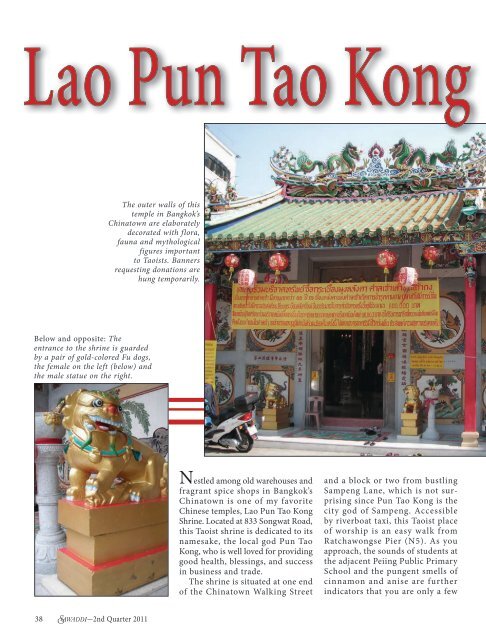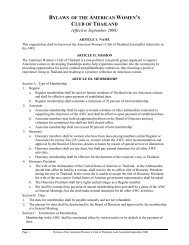Lao Pun Tao Kong Shrine
Lao Pun Tao Kong Shrine
Lao Pun Tao Kong Shrine
Create successful ePaper yourself
Turn your PDF publications into a flip-book with our unique Google optimized e-Paper software.
<strong>Lao</strong> <strong>Pun</strong> <strong>Tao</strong> <strong>Kong</strong><br />
The outer walls of this<br />
temple in Bangkok’s<br />
Chinatown are elaborately<br />
decorated with flora,<br />
fauna and mythological<br />
figures important<br />
to <strong>Tao</strong>ists. Banners<br />
requesting donations are<br />
hung temporarily.<br />
Below and opposite: The<br />
entrance to the shrine is guarded<br />
by a pair of gold-colored Fu dogs,<br />
the female on the left (below) and<br />
the male statue on the right.<br />
Nestled among old warehouses and<br />
fragrant spice shops in Bangkok’s<br />
Chinatown is one of my favorite<br />
Chinese temples, <strong>Lao</strong> <strong>Pun</strong> <strong>Tao</strong> <strong>Kong</strong><br />
<strong>Shrine</strong>. Located at 833 Songwat Road,<br />
this <strong>Tao</strong>ist shrine is dedicated to its<br />
namesake, the local god <strong>Pun</strong> <strong>Tao</strong><br />
<strong>Kong</strong>, who is well loved for providing<br />
good health, blessings, and success<br />
in business and trade.<br />
The shrine is situated at one end<br />
of the Chinatown Walking Street<br />
and a block or two from bustling<br />
Sampeng Lane, which is not surprising<br />
since <strong>Pun</strong> <strong>Tao</strong> <strong>Kong</strong> is the<br />
city god of Sampeng. Accessible<br />
by riverboat taxi, this <strong>Tao</strong>ist place<br />
of worship is an easy walk from<br />
Ratchawongse Pier (N5). As you<br />
approach, the sounds of students at<br />
the adjacent Peiing Public Primary<br />
School and the pungent smells of<br />
cinnamon and anise are further<br />
indicators that you are only a few<br />
S<br />
38 awadd i—2nd Quarter 2011
<strong>Shrine</strong><br />
A Wealth<br />
of<br />
Decor<br />
&<br />
Deities<br />
Text by Carol Foutz Stephens<br />
Photographs by Carol Foutz Stephens and<br />
Thomas M. Stephens<br />
steps away from your destination.<br />
The original shrine was built by<br />
overseas Chinese in the time of King<br />
Rama III (r. 1824–1851). A construction<br />
project was conducted in<br />
the 1940s to renovate the property.<br />
This was followed by a more recent<br />
restoration in 2007 to mark<br />
the celebration of His Majesty King<br />
Bhumibol Adulyadej’s 80th birthday.<br />
Members of the 34th Generation<br />
of the Taechew Association greatly<br />
supported and masterminded these<br />
changes, and this association maintains<br />
the shrine today. The present<br />
building is 66 years old.<br />
The ornately decorated red Chinese<br />
arch, or gateway, in front of the<br />
shrine is topped by two green dragons<br />
chasing a flaming pearl, a wellknown<br />
Chinese motif. Meeting in the<br />
middle in a friendly face-off, unlike<br />
the more fearsome dragons of medieval<br />
times, these Chinese dragons<br />
Sawad d i—2nd Quarter 2011<br />
39
Colorful ceramic warriors stand ready<br />
to defend against evil.<br />
Tua <strong>Lao</strong>ia <strong>Kong</strong> takes center stage in<br />
the back of the shrine.<br />
Dragons chasing a flaming pearl atop the gateway entrance are motifs<br />
commonly seen at Chinese shrines.<br />
pictures of an elephant and a lion<br />
denote strength. If you look upward<br />
at the tiled area under the roof, you<br />
will see a favorite creature—the qilin<br />
(unicorn)—who is known for kindness<br />
and benevolence. Legend claims<br />
that if you see one, it is an omen<br />
of wonderful things ahead. It also<br />
signifies longevity as well as wise<br />
administration and felicity. Another<br />
tile depicts several ducks which,<br />
especially when in pairs, symbolize<br />
conjugal fidelity.<br />
The frames surrounding pictures<br />
are also symbolic. Butterflies, which<br />
are associated with joy, appear in the<br />
corners of some of the smaller illusare<br />
positive figures representing life,<br />
change and protection.<br />
The outside of the shrine is a veritable<br />
feast of Chinese symbols and<br />
art. On its roof are more dragons,<br />
their serpentine tails waving in the<br />
wind as they sail across the horizon.<br />
Chinese warriors placed strategically<br />
along cascading beams also<br />
stand guard, prepared to fight off<br />
any intruders.<br />
On the outer shrine walls the God<br />
of Longevity holds his characteristic<br />
staff. White cranes standing<br />
under pine trees along with a painting<br />
of bamboo—all symbols of long<br />
life—are featured as well. Separate<br />
trations. Lotus flowers are employed<br />
to enhance meaning. Outlining some<br />
of the larger representations is the<br />
Greek key design, or meander, a<br />
common ornamentation used to fill<br />
in empty space and create positive<br />
energy.<br />
The entrance to the shrine is<br />
graced by a pair of gold-colored Fu<br />
dogs, also known as temple dogs or<br />
lions. The male statue, sometimes<br />
just a bit larger than the female, is<br />
placed on the right of the entrance<br />
and has one paw resting on top of a<br />
ball, which represents the world. The<br />
female statue is placed on the left, in<br />
accordance with tradition, and her<br />
S<br />
40 awadd i—2nd Quarter 2011
The elusive qilin (Chinese unicorn) has the body of<br />
a horse covered with fish scales and two horns bent<br />
backward.<br />
The white tiger, guardian of the west, is the king of<br />
wild beasts and exemplifies courage.<br />
A popular local god, <strong>Lao</strong> <strong>Pun</strong> <strong>Tao</strong> <strong>Kong</strong> is honored daily by<br />
a stream of visitors who light candles and incense sticks at<br />
this shrine.<br />
paw rests on a baby Fu dog, which<br />
represents the family. In addition,<br />
the male statue protects the outer<br />
premises while the female guards<br />
the inside of the buildings.<br />
Inside the shrine and immediately<br />
to the left, you will see an alcove honoring<br />
<strong>Pun</strong> <strong>Tao</strong> <strong>Kong</strong>. The altar table<br />
before him displays several temple<br />
dogs and some blue-and-white vases<br />
depicting the Eight Immortals, a very<br />
important group of legendary figures<br />
in <strong>Tao</strong>ist mythology.<br />
Further inside, you come to two<br />
small ponds. On the left is the White<br />
Tiger Pond. A mosaic of a white tiger,<br />
who is the guardian of the west, is<br />
displayed on the wall to symbolize<br />
courage and the summer season. On<br />
the opposite wall is the Green Dragon<br />
Pond with a mosaic of an imposing<br />
green dragon swirling above it.<br />
Known for possessing spiritual powers,<br />
this dragon who is the guardian<br />
of the east represents fertility and the<br />
spring season. Both these chimerical<br />
creatures stand ready to fend off any<br />
would-be attackers.<br />
Next you pass a central offering<br />
table and two bells. The bell on the<br />
left is antique while the one on the<br />
right is more recently made. The<br />
bells are rung whenever someone<br />
makes a donation to the shrine.<br />
Moving to the back of the building,<br />
you see three altars, or minishrines.<br />
The middle altar pays<br />
homage to the god Tua <strong>Lao</strong>ia <strong>Kong</strong>.<br />
He sits holding a sword, and his feet<br />
rest upon a turtle. He is flanked on<br />
the right by a shrine to Tua <strong>Pun</strong> <strong>Tao</strong><br />
<strong>Kong</strong> and on his left, a shrine to Jui<br />
Hoksing.<br />
Since predicting the future is an<br />
important <strong>Tao</strong>ist concept, you may<br />
want to throw some divination sticks<br />
before you leave. These sticks can<br />
be found bunched in a container on<br />
one of the altar tables. Make your<br />
donation and then simply shake the<br />
container until a numbered stick<br />
Sawad d i—2nd Quarter 2011<br />
41
The large bell on<br />
the left represents<br />
peace and good luck.<br />
Paper offerings are<br />
burned in the colorful<br />
incinerator beside the<br />
bell.<br />
Muengsing, the door god, is an imposing figure located<br />
on both the left and right entrance doors of the temple to<br />
ensure people can come and go safely.<br />
Divination sticks (above right) are used by<br />
<strong>Tao</strong>ists to learn the future (below).<br />
falls out. Then proceed to the red<br />
boxes by the door where you will receive<br />
a poem from the appropriately<br />
numbered slot. Since this advice<br />
will be in Thai, you may want to<br />
have it translated by one of the staff<br />
specialists. Other ways to increase<br />
your good fortune are to make an<br />
offering by burning joss sticks, by<br />
lighting a candle or, of course, by<br />
making a donation.<br />
On the way out, do not miss<br />
the paintings of the door god,<br />
Muengsing, who has been guarding<br />
you during your visit, ensuring<br />
that no ghosts, spirits or demons of<br />
any kind threaten you or the shrine.<br />
A fearsome figure, his picture is on<br />
both inside doors.<br />
S<br />
42 awadd i—2nd Quarter 2011<br />
<strong>Lao</strong> <strong>Pun</strong> <strong>Tao</strong> <strong>Kong</strong> <strong>Shrine</strong> is a<br />
wonderful contrast to the rest of<br />
Chinatown with its hustle and bustle,<br />
crowded streets and cacophony<br />
of everyday sounds. I love entering<br />
this quiet world of color, characters<br />
and creativity. And thanks to the<br />
presence of the <strong>Tao</strong>ist deities and<br />
the plethora of good luck symbols,<br />
I always leave feeling more<br />
peaceful and protected than when<br />
I arrived. ❖<br />
Carol Stephens wrote her first article for<br />
Saw a d d i Magazine in 1995. She and<br />
her husband, Tom Stephens, are living<br />
in Bangkok for a second time. Traveling<br />
and experiencing Asian cultures are<br />
among their many interests.<br />
Author’s Note: Because<br />
of the popularity of this<br />
local god, there is another<br />
<strong>Lao</strong> <strong>Pun</strong> <strong>Tao</strong> <strong>Kong</strong> <strong>Shrine</strong><br />
in Chinatown only a few<br />
blocks away, which is not<br />
the subject of this article.<br />
This older sanctuary is on<br />
a lane called Trok San Chao<br />
Mai and can be reached<br />
by climbing up a number<br />
of stairs.





